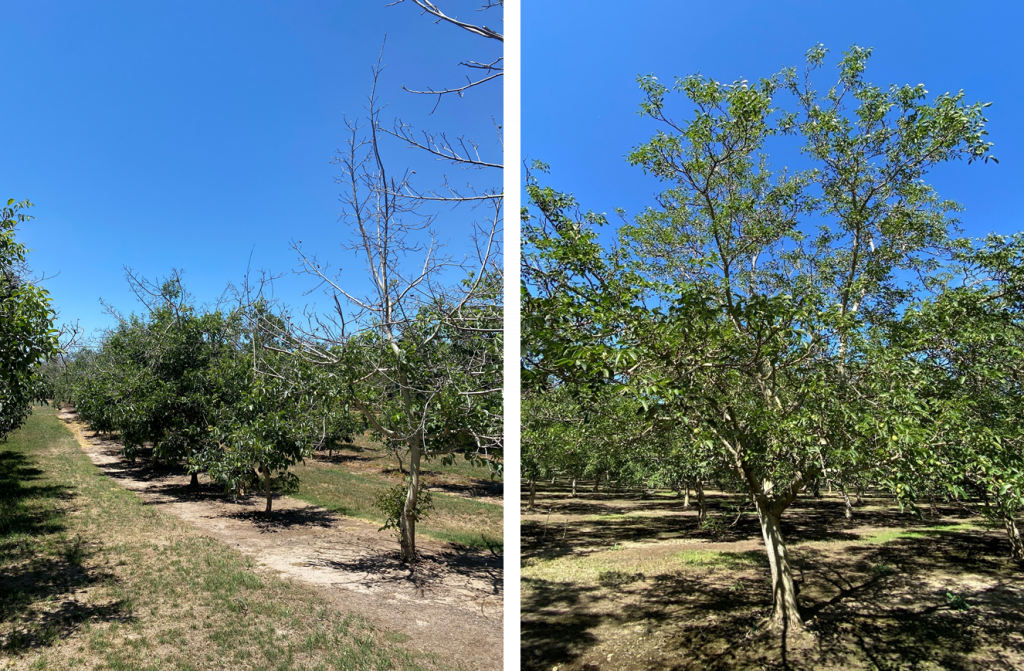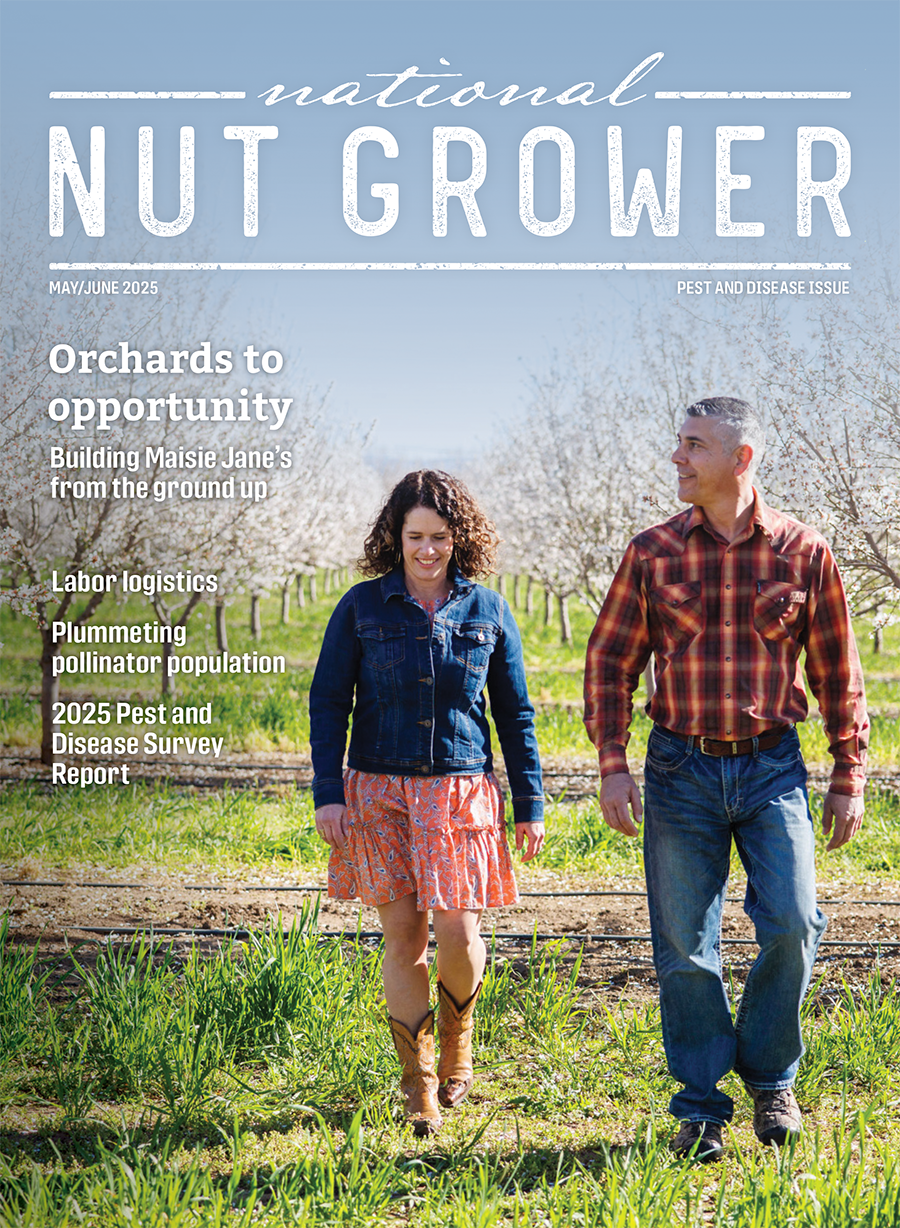
Jul 7, 2021Road to recovery: 2020 walnut freeze in northern Sacramento Valley
2020 brought yet another major autumn freeze. There were also sudden autumn freeze events in November of 2018 and 2019, however, observations in the northern Sacramento Valley indicate that the autumn 2020 freeze damage was more extensive than damage from either of the previous two years.
Conversely, farm advisors as well as agricultural commissioners in central and southern Sacramento Valley counties received fewer freeze calls in the spring of 2021 than they had in spring 2019.
Our best guess for explaining the walnut freeze damage observed in 2021 are freeze events on the mornings of Nov. 10 and 12, 2020. Temperatures had previously been unusually warm in the first two weeks of November with highs around 80 degrees during the first week and only one morning of temperatures near freezing, before temperatures dropped well below freezing on the 10th and 12th. Details on why severe damage may have occurred can be found in our previous post on the November 2020 freeze.
Below are descriptions of the freeze surveying and reporting being performed by County Agricultural Commissioners, the USDA Farm Service Agency, and UC Cooperative Extension.
Agricultural Commissioners in Butte, Glenn, and Tehama Counties initiated grower surveys in spring 2021 to assess if a crop disaster declaration was warranted. The Butte County Agricultural Commissioner’s Office concluded that the county did not meet the 30% crop loss or tree loss needed to file a damage assessment report with the CDFA and CalOES. At the time of this writing, surveys in Glenn and Tehama Counties are ongoing. County Agricultural Commissioner’s offices in Sutter, Yuba, Colusa, Yolo, Solano, and Sacramento Counties did not receive sufficient grower reports of freeze damage to warrant conducting surveys.
The USDA Farm Services Agency (FSA) encourages walnut growers who experienced losses from the 2020 autumn freeze to report losses to their local Farm Service Agency (FSA) office:
These are the two USDA FSA programs you may qualify to apply for.
UC Cooperative Extension researchers will also be conducting a walnut freeze damage survey. This online survey will ask about the orchard characteristics and grower practices surrounding freeze damaged orchards, with the hope of refining best practices for preventing future freeze damage. Look out for this survey from your local orchard advisor as well as at sacvalleyorchards.com later this summer.
Finally, save the date for a Zoom webinar tentatively scheduled forWednesday, Sept. 1 from 4-5:30 p.m. when Luke Milliron will be hosting a panel of UC researchers and walnut growers to share their experience and lessons learned in preventing sudden autumn freeze damage.
What to do now with freeze damaged orchards:
- Sunburn: Consider protecting exposed wood from sunburn by painting the southwest side of trunks or limbs with tree paint or white latex paint 50:50. We understand however, that this is likely a cost-prohibitive practice. Pay close attention to signs of sunburn on the nuts which can predispose walnuts to mold infection. See the article in this newsletter on mold in walnuts to learn more about managing the disease.
- Water: Use a pressure chamber and/or soil moisture to avoid over-irrigating. With less leaf surface (Photo 1 and 2), there is less transpiration. The pressure chamber is a direct measure of whether the trees need irrigation. Wait until pressure chamber readings are 2 to 3 bars below baseline before irrigating. Overwatering freeze affected trees will damage roots, likely leading to tree collapse, instead of recovery. You can learn more about using the pressure chamber in walnuts form our article on Advanced Stem Water Potential Interpretation in Walnut.
- Nutrition: Hopefully, you have been fertilizing appropriately. Much of the nitrogen demand is from the crop, and therefore nitrogen applications should be reduced in relation to any expected yield reduction in freeze damaged orchards. Take a July leaf sample to check on your nutrition program for all nutrients (see details in the July crop considerations).
- Botryosphaeria (Bot) or Phomopsis: If you haven’t already started doing so, remove dead limbs and prunings from the orchard as they may become infected with Botryosphaeria (Bot) or Phomopsis. Again, with some orchards experiencing tremendous dieback, the removal of small branches may be cost-prohibitive.
In orchards where there is a history of Bot infection, some growers reported plans to apply a Bot spray by early July, whether or not deadwood removal was completed. For both deciding what to do with prunings and how aggressively to treat for Bot, it’s critical to assess what the infection level is in each orchard (table 1). Unsurprisingly the treatment regiment becomes more aggressive with increasing infection, however it becomes less critical for handling prunings at the highest infection rates because there is already such a high inoculum load present. You can learn more about Botryosphaeria and Phomopsis cankers from our article on Managing Bot Canker and Blight in Walnut.

Photo 1 (L) and Photo 2 (R). Photo 1 (L) of a 9th leaf Howard orchard in Butte County shows the clear dieback, particularly higher in the canopy, that we typically associate with freeze damage symptoms (6/3/2021, photo by Luke Milliron). Photo 2 (R) shows a very thin canopy on June 10, 2020 in this Glenn County 15th leaf Chandler orchard is also likely due to freeze damage, specifically due to delayed budbreak (6/10/2021, photo by Luke Milliron).









